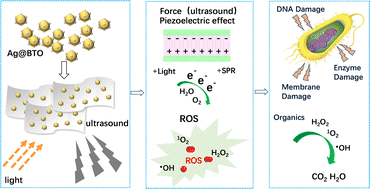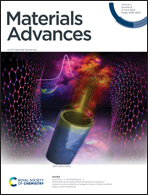A heterostructure nanofiber film with an enhanced internal electrical field and surface plasmon resonance for efficient microbial removal†
Abstract
Severe water pollution has posed a great threat to human health and aquatic organisms, leading to serious damage to aquatic ecosystems. Reactive oxygen species is essential in the degradation of water pollutants via a redox reaction. Here we report boosted and controllable generation of reactive oxygen species and subsequent removal of organics through ultrasonic and light-activated photo-piezocatalysis enabled by a nanofiber film. A Ag@BaTiO3 nano hybrid seeded polyvinylidene fluoride (PVDF) composite fiber film with enhanced β phase content was fabricated using electrospinning. The piezoelectric device made of the Ag@BaTiO3/PVDF fiber film displayed enhanced piezoelectric performance, with an open circuit voltage of approximately 6.3 V and a short circuit current of 0.497 μA under 3.39 N pressure. The rate of reactive oxygen species generated via continued ultrasonic irradiation of the heterostructured fiber film is significantly faster than that of the pure PVDF film. The film allows efficient degradation of water pollutants (degradation rate 81%) and removal of microbial species (99% clearance of E. coli) via a concerted route of photo-piezocatalysis. In summary, the use of a heterostructured PVDF nanofiber film is an effective approach to induce an integral electrical field and to piezocatalytically generate aqueous ROS, which is desirable in environmental pollution control.



 Please wait while we load your content...
Please wait while we load your content...